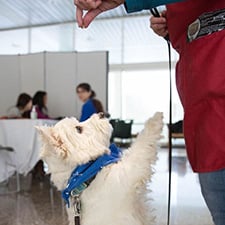Dogs and other pets have comforted patients in hospitals, clinics and nursing homes for years. Could these animals also be a good stress-management technique for doctors, nurses and other health professionals caring for those patients?
Preliminary results from one hospital that’s tried it indicate the answer is yes.
Once a month, physicians, nurses and others on staff at Rush University Medical Center in Chicago and at Rush’s suburban Oak Park campus have a chance to get away from the hustle and bustle of treating patients and spend some time petting therapy dogs.
Paws that refresh
It’s part of a program called Pet Pause that aims to reduce stress and promote well-being in the high-pressure work environment.
Nursing leadership runs the program and in 2016 they began studying the impact it was having on staff members who participated. When a staff member agrees to participate in the study, they had their blood pressure measured and then self-reported stress levels on a scale of 1 to 10, with 10 being the highest level of stress. Those two measures are collected again after staff members finish petting the dogs and head back to work.
The study wrapped up in September and researchers are crunching the final results from the nearly 700 participants at the two sites. But a preliminary look at data from the first 10 months of the program shows that the dogs are having a positive impact, said Mary Heitschmidt, PhD, APRN, CCRN, principal investigator of the study. Heitschmidt is the director of clinical research, co-director of the Center for Clinical Research and Scholarship, and assistant professor at Rush.
For example, coming into the room to pet the dogs, participants on average said they had a stress level of 4.75 on that one-to-10 scale. After petting the dogs, the physicians, nurses and others who participated in the Pet Pause study reported a stress level that averaged 3.25.
“People like it,” Heitschmidt said of the program. “It’s a good break and it increases morale.”
How to replicate the program
Putting together the Pet Pause Program hasn’t required much monetary investment, but it has required a lot of teamwork between the hospitals, nursing students and the therapy-dog owners to bring the pieces together.
Nurses reach out to volunteers to bring in the therapy dogs from places such as Chicago-based Canine Therapy Corp. and the Anti-Cruelty Society of Chicago. Dogs range in size and breed and include a Westie, Labradoodles, Goldendoodles and a German Shepherd mix. Those leading the initiative also must reserve space in the hospitals to bring the animals and hospital staff together. Advertising and marketing the program is a big piece of it as well, Heitschmidt said.
“It’s not hard. It’s just time- and labor-intensive to get it going,” she said. “Once it’s going, it is easy to keep it going.”
One of many stress-reduction efforts
With physician and nurse burnout a big concern in health care, animal therapy is one of a number of stress-reduction efforts at Rush. In addition to the dogs, miniature horses came in one time too.
Rush is considering the addition of music and art therapy for the staff and there are mindfulness classes staff members can take. Among other initiatives, the oncology ambulatory area at the Chicago site has a stress-relief room that includes a massage chair, music, water and even chocolate.
“You swipe your card for access and it’s a place where anyone can go to take a time out,” Heitschmidt said. She said the nurses who led this initiative are taking an evidence-based look at the project and results indicate that it is having a positive impact on staff. Another area of the medical center is now converting a closet to serve as a similar place to recharge.
“There is a whole initiative around stress and burnout,” Heitschmidt said. “We’re focusing on people on the front lines—doctors, nurses—and helping them in any way we can.”
Committed to making physician burnout a thing of the past, the AMA has studied, and is addressing, issues causing and fueling physician burnout—including time constraints, technology and regulations—to better understand the challenges physicians face.
This AMA STEPS Forward™ CME module, “Creating the Organizational Foundation for Joy in Medicine,™” offers concrete steps to help you create a joyful practice environment and thriving workforce.
AMA’s STEPS Forward is an open-access platform featuring more than 50 modules that offer actionable, expert-driven strategies and insights supported by practical resources and tools. Based on best practices from the field, STEPS Forward modules empower practices to identify areas or opportunities for improvement, set meaningful and achievable goals, and implement transformative changes designed to increase operational efficiencies, elevate clinical team engagement, and improve patient care.
Several modules have been developed from the generous grant funding of the federal Transforming Clinical Practices Initiative (TCPI), an effort designed to help clinicians achieve large-scale health transformation through TCPI’s Practice Transformation Networks.
The AMA, in collaboration with TCPI, is providing technical assistance and peer-level support by way of STEPS Forward resources to enrolled practices. The AMA is also engaging the national physician community in health care transformation through network projects, change packages, success stories and training modules.




